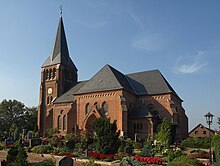Ernst Wiehe
Johann Karl Ernst Wiehe (born November 17, 1842 in Braunschweig , † August 1, 1894 in Reichenhall ) was a German architect and Brunswick construction clerk .
life and work
Coming from a family of builders, Wiehe graduated from secondary school in his hometown and studied at the Collegium Carolinum from 1858 to 1861 . He became an employee of the city building councilor Carl Tappe , whom he supported in the renovation of the medieval Brothers Church . After completing the First State Examination in 1864, Wiehe went to Vienna from 1865 to 1866 to study Gothic architecture at the Academy of Fine Arts under the cathedral builder Friedrich von Schmidt (1825-1891) . The study visit was formative for his devotion to medieval, especially Gothic architecture. Returning to Braunschweig, he passed the second state examination (master builder examination ) in 1866 .
Wiehe had been with Luise, born in 1869. Little cousin, married with whom he had six children. He died in Reichenhall in 1894.
His successor in the building management was building officer Johannes Pfeifer .
Ducal district architect
In 1867 he was commissioned by the Braunschweig district directorate to build the church in Thedinghausen . From 1869 to 1872 Wiehe worked as a construction manager in the secretariat of the ducal building management before he was appointed district architect in 1873 to succeed Friedrich Maria Krahe . In 1874 he designed the neo-Gothic churches in Rüningen and Lunsen , which served as a model for other rural church buildings. Since 1876 Wiehe was responsible for the restoration of the country's former monastery churches. Among other things, the Riddagshausen monastery church and the Königslutter collegiate church have been restored.
Building councilor in the ducal building management
In 1877 Wiehe was appointed building councilor and a voting member not only of the ducal building management, but also of the consistory . Since he was able to act on behalf of the state as well as the church, it was possible for him to undertake a uniform design and promotion of church and school building in the Duchy of Braunschweig . His basic idea was to create variable basic models for each type of building that could be adapted to the respective conditions. This had become necessary because at the end of the 19th century the population increased at different rates depending on the local industrial settlement. His planning guidelines, often only carried out in the form of sketches, left the building officials in the seven ducal building inspections spread across the country enough room for maneuver. The project planning and execution of the new school and church buildings corresponded to the practical needs and at the same time also to the aesthetic ideas of the time.
Restoration of the Brunswick Cathedral
Wiehe's life's work was the restoration of the Brunswick Cathedral , which he carried out in several stages since 1876, partly together with August Essenwein (1831-1892). The furnishings were restored in Romanesque forms. Between 1889 and 1891 the neo-Romanesque sacristy and baptistery he designed were built on the southern cross arm.
Further buildings in Braunschweig
In 1883 the new Marienstift building was opened on Helmstedter Strasse. The new grammar school , since 1906 Wilhelm grammar school , was inaugurated in 1885. He designed the tax office building (today NORD / LB ) in Dankwardstraße and the hostel for Heimat on Juliusstraße, which was inaugurated in 1876 . It was demolished in 1971 due to its dilapidation.
literature
- Paul Zimmermann : Wiehe, Ernst . In: Allgemeine Deutsche Biographie (ADB). Volume 44, Duncker & Humblot, Leipzig 1898, pp. 492-495.
- Horst-Rüdiger Jarck , Günter Scheel (Ed.): Braunschweigisches Biographisches Lexikon - 19th and 20th centuries . Hahnsche Buchhandlung, Hannover 1996, ISBN 3-7752-5838-8 , p. 653-654 .
- Manfred Garzmann , Wolf-Dieter Schuegraf (Ed.): Braunschweiger Stadtlexikon . Supplementary volume. Joh. Heinr. Meyer Verlag, Braunschweig 1996, ISBN 3-926701-30-7 , p. 138-139 .
Individual evidence
- ↑ Literature by and about Johannes Pfeifer in the catalog of the German National Library
- ↑ Communications from the division of the Ducal Building Direction in Braunschweig per 1893/94, George Westermann, Braunschweig 1896, p. 2.
- ↑ Falko Rost: The architect Ernst Wiehe (1842-1894): Cultural transfer between Braunschweig and Thedinghausen. In: Braunschweigische Heimat, Appelhans, Braunschweig 2007, p. 8ff.
- ^ Falko Rost: Church buildings of the 19th century in the Helmstedt area. In: Kreisbuch 2001: Landkreis Helmstedt 2000, 8th year, Landkreis Helmstedt, pp. 13–24.
- ↑ http://imwestennichtsneues.blogsport.de/historie/die-herberge-zur-heimat/ accessed on August 13, 2014
- ^ Klaus Hoffmann: Herberge zur Heimat. In: Neue Westpost Nr.05 - 7.Jg. May 2013, p. 12. (there two photos)
| personal data | |
|---|---|
| SURNAME | Wiehe, Ernst |
| ALTERNATIVE NAMES | Wiehe, Johann Karl Ernst |
| BRIEF DESCRIPTION | German architect |
| DATE OF BIRTH | November 17, 1842 |
| PLACE OF BIRTH | Braunschweig |
| DATE OF DEATH | August 1, 1894 |
| Place of death | Reichenhall |


